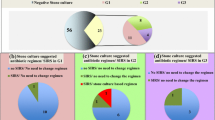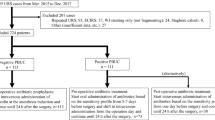Abstract
To evaluate the correlation between preoperative urine culture and stone culture findings during PCNL and choosing the appropriate antimicrobial treatment of patients with urinary tract infection or SIRS after PCNL. From April 2007 to March 2008, 51 patients aged 24–66 years underwent PCNL under general anesthesia. Statistical analysis was performed using SPSS software (v.18), the Kolmogorov–Smirnov test, Student’s t test, and the Chi square or Fisher’s exact tests. Before operation, 11 patients (21.6 %) had positive urine culture. Sixteen patients (31.4 %) had positive stone culture during operation. SIRS occurred in 13 patients (25.5 %). In female group (10 cases, 45.5 %), SIRS was significantly higher than male group (3 cases, 10.3 %) (P = 0.008). Positive stone culture was significantly more prevalent in cases with positive pre-operative urine culture than cases with negative pre-operative urine culture (P = 0.023). But positive stone culture in group with SIRS, was significantly more common than group without SIRS (P = 0.001). Also positive stone culture in female group had significantly higher than male group (P = 0.003). We found a significant, tenfold increase in the risk of developing SIRS after PNCL, only in patients with positive stone culture (OR = 9.96; 95 % CI = 2.37–41.85, P = 0.002). Positive stone culture is a significant predictor of SIRS after PCNL, regardless of other related factors. Therefore, in order to avoid using blind empirical antibiotic regimen and to reduce the risk of subsequent microbial resistance due to use of prevalent broad-spectrum antibiotics, it would be wise to choose appropriate antibiotic therapy based on the results of intraoperative stone culture.
Similar content being viewed by others
References
Cadeddu JA, Chen R, Bishoff J, Micali S, Kumar A, Moore RG et al (1998) Clinical significance of fever after percutaneous nephrolithotomy. Urology 52(1):48–50
Deitch EA, Goodman ER (1999) Prevention of multiple organ failure. Surg Clin North Am 79(6):1471–1488
O’Keeffe N, Mortimer A, Sambrook P, Rao P (1993) Severe sepsis following percutaneous or endoscopic procedures for urinary tract stones. Br J Urol 72(3):277
Buck AC (1988) The use of noxythiolin (Noxyflex ‘S’) as an antiseptic irrigant in upper urinary tract drainage following percutaneous nephrolithotomy. Br J Urol 62:306–310. doi:10.1111/j.1464-410X.1988.tb04353.x
Chen L, Xu QQ, Li JX et al (2008) Systemic inflammatory response syndrome after percutaneous nephrolithotomy: an assessment of risk factors. Int J Urol 15(12):1025–1028. doi:10.1111/j.1442-2042.2008.02170.x
Bone RC, Balk RA, Cerra FB, Dellinger RP, Fein AM, Knaus WA et al (1992) Definitions for sepsis and organ failure and guidelines for the use of innovative therapies in sepsis. The ACCP/SCCM Consensus Conference Committee. American College of Chest Physicians/Society of Critical Care Medicine. Chest J 101(6):1644–1655
Hierholzer C, Billiar TR (2001) Molecular mechanisms in the early phase of hemorrhagic shock. Langenbeck’s Archiv Surg 386(4):302–308
Mueller L, Broering DC, Meyer J, Vashist Y, Goettsche J, Wilms C et al (2002) The induction of the immediate-early-genes Egr-1, PAI-1 and PRL-1 during liver regeneration in surgical models is related to increased portal flow. J Hepatol 37(5):606–612
Nemoy NJ, Stamey TA (1971) Surgical, bacteriological, and biochemical management of infection stones. JAMA J Am Med Assoc 215(9):1470–1476
Dunne JR, Malone DL, Tracy JK, Napolitano LM (2004) Allogenic blood transfusion in the first 24 hours after trauma is associated with increased systemic inflammatory response syndrome (SIRS) and death. Surg Infect 5(4):395–404
Mariappan P, Smith G, Bariol SV, Moussa SA, Tolley DA (2005) Stone and pelvic urine culture and sensitivity are better than bladder urine as predictors of urosepsis following percutaneous nephrolithotomy: a prospective clinical study. J Urol 173(5):1610–1614
Wolf JS Jr, Bennett CJ, Dmochowski RR, Hollenbeck BK, Pearle MS, Schaeffer AJ (2008) Best practice policy statement on urologic surgery antimicrobial prophylaxis. J Urol 179(4):1379–1390 Epub 2008/02/19
Dogan HS, Guliyev F, Cetinkaya YS, Sofikerim M, Ozden E, Sahin A (2007) Importance of microbiological evaluation in management of infectious complications following percutaneous nephrolithotomy. Int Urol Nephrol 39(3):737–742 Epub 2007/02/13
Margel D, Ehrlich Y, Brown N, Lask D, Livne PM, Lifshitz DA (2006) Clinical implication of routine stone culture in percutaneous nephrolithotomy–a prospective study. Urology 67(1):26–29 Epub 2006/01/18
Sharifi Aghdas F, Akhavizadegan H, Aryanpoor A, Inanloo H, Karbakhsh M (2006) Fever after percutaneous nephrolithotomy: contributing factors. Surg Infect 7(4):367–371
Fowler JE Jr (1984) Bacteriology of branched renal calculi and accompanying urinary tract infection. J Urol 131(2):213–215
Korets R, Graversen JA, Kates M, Mues AC, Gupta M (2011) Post-percutaneous nephrolithotomy systemic inflammatory response: a prospective analysis of preoperative urine, renal pelvic urine and stone cultures. J Urol 186(5):1899–1903
Lojanapiwat B, Kitirattrakarn P (2011) Role of preoperative and intraoperative factors in mediating infection complication following percutaneous nephrolithotomy. Urol Int 86:448–452. doi:10.1159/000324106
Tolley DA, Segura JW (2002) Fast facts—urinary stones. Health Press, Oxford
Conflict of interest
None.
Author information
Authors and Affiliations
Corresponding author
Rights and permissions
About this article
Cite this article
Roushani, A., Falahatkar, S., Hosseini Sharifi, S.H. et al. Intra-operative stone culture as an independent predictor of systemic inflammatory response syndrome after percutaneous nephrolithotomy. Urolithiasis 42, 455–459 (2014). https://doi.org/10.1007/s00240-014-0688-6
Received:
Accepted:
Published:
Issue Date:
DOI: https://doi.org/10.1007/s00240-014-0688-6




